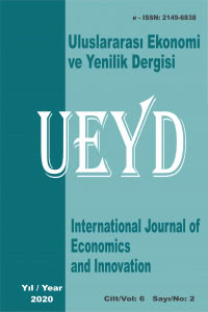Türkiye’nin Ekonomi Politikasının Üçlü Açmaz Bağlamında İncelenmesi
Investigating Economic Policy of Turkey in the Context of Impossible Trinity
___
- Aizenman, J., & Ito, H. (2011). The ‘impossible trinity,’the international monetary framework, and the Pacific Rim. Forthcoming in IN Kaur and N. Singh ed., Handbook of the Economics of the Pacific Rim.
- Aizenman, J., & Sengupta, R. (2011). The financial trilemma in China and a comparative analysis with India, MRPA Paper No. 34485, University of California, Santa Cruz, CA.
- Aizenman, J., Chinn, M. D., & Ito, H. (2008). Assessing the emerging global financial architecture: Measuring the trilemma's configurations over time (No. w14533). National Bureau of Economic Research.
- Aizenman, J., Chinn, M. D., & Ito, H. (2010). The emerging global financial architecture: Tracing and evaluating new patterns of the trilemma configuration. Journal of international Money and Finance, 29(4), 615-641.
- Akcelik, Y., Cortuk, O., & Turhan, I. (2014). Mitigating Turkey’s trilemma tradeoffs. Emerging Markets Finance and Trade, 50(6), 102-118.
- Benlialper, A., & Cömert, H. (2016). Implicit asymmetric exchange rate peg under inflation targeting regimes: the case of Turkey. Cambridge Journal of Economics, 40(6), 1553-1580.
- Chinn, M. D., & Ito, H. (2006). What matters for financial development? Capital controls, institutions, and interactions. Journal of development economics, 81(1), 163-192.
- Chinn, M. D., & Ito, H. (2008). A new measure of financial openness. Journal of comparative policy analysis, 10(3), 309-322.
- Cortuk, O., & Singh, N. (2011). Turkey’s trilemma trade-offs: is there a role for reserves?.
- Dickey, D. A., & Fuller, W. A. (1979). Distribution of the estimators for autoregressive time series with a unit root. Journal of the American statistical association, 74(366a), 427-431.
- Fischer, S. (2001). Exchange rate regimes: is the bipolar view correct?. Journal of economic perspectives, 15(2), 3-24.
- Fleming, J. M. (1962). Domestic financial policies under fixed and under floating exchange rates. Staff Papers, 9(3), 369-380.
- Frankel, J. A. (1999). No single currency regime is right for all countries or at all times (No. w7338). National Bureau of Economic Research.
- Goldstein, M. (2002). Managed Floating Plus, Institute for International Economics, Washington. Mishkin, F.S., Schmidt-Hebbel, K., 2007. Does Inflation Targeting Make a Difference? NBER Working Paper #12876. National Bureau of Economic Research, Cambridge, MA.
- Mundell, R. A. (1963). Capital mobility and stabilization policy under fixed and flexible exchange rates. The Canadian Journal of Economics and Political Science/Revue canadienne d'Economique et de Science politique, 29(4), 475- 485.
- Obstfeld, M. (1998). The global capital market: benefactor or menace?. Journal of economic perspectives, 12(4), 9-30.
- Obstfeld, M., & Taylor, A. M. (1998). The great depression as a watershed: international capital mobility over the long run. In The defining moment: The Great Depression and the American economy in the twentieth century (pp. 353-402). University of Chicago Press.
- Obstfeld, M., Shambaugh, J. C., & Taylor, A. M. (2005). The trilemma in history: tradeoffs among exchange rates, monetary policies, and capital mobility. Review of Economics and Statistics, 87(3), 423-438.
- Pesaran, M. H., Shin, Y., & Smith, R. J. (2001). Bounds testing approaches to the analysis of level relationships. Journal of applied econometrics, 16(3), 289- 326.
- Süslü, B. (2001). Türkiye’de 1990 sonrası izlenen faiz politikası. Muğla Üniversitesi Sosyal Bilimler Enstitüsü Dergisi, (3).
- Williamson, J. (2000). Exchange Rate Regimes for Emerging Markets, Reviving the Intermediate Option, Institute for International Economics, Washington.
- Yalçıner, K., Çetinkaya, M., & Çevik, Y. E. (2017). Türkiye’nin ‘De Facto’Döviz Kuru Rejiminin Belirlenmesi. Selçuk Üniversitesi Sosyal Bilimler Enstitüsü Dergisi, (37), 265-272
- ISSN: 2149-6838
- Yayın Aralığı: Yılda 2 Sayı
- Başlangıç: 2015
- Yayıncı: Seyfettin Artan
Türkiye’nin Ekonomi Politikasının Üçlü Açmaz Bağlamında İncelenmesi
Duygu ARSLANTÜRK ÇÖLLÜ, Leyla AKGÜN, Ecevit EYDURAN
Bilgi ve İletişim İktisadi Faaliyetinin İşsizlik Oranı Üzerindeki Kısa ve Uzun Dönem Etkileri
Baran Can SAĞLAM, Havvanur Feyza KAYA
Türkiye'nin Ekonomi Politikasının Üçlü Açmaz Bağlamında İncelenmesi
Uluslararası Yatırımcılar, Volatilite ve Sürü Davranışı: Borsa İstanbul, 2001-2016
Burak DİNDAROĞLU, Ezgi AKÇAALAN, Ayla Oğuş BİNATLI
Gastronomi Marka Değeri Bileşenlerinin Seyahat Niyeti Üzerine Etkisi: Bir Rota Örneği
Sibel OĞUZ, Zafer BUZCU, Murat İsmet HASEKİ
Kerem ERDEM, Ayben KOY, Saffet AKDAĞ
Türkiye’de Eğitim ve Ekonomik Büyüme İlişkisi: Fourier-Shin Eşbütünleşme Testi
İktisadi Büyüme ve Yolsuzluk İlişkisi: Türkiye için Ampirik Bir İnceleme
The Effect of Gastronomy Brand Value Components on Travel Intention: A Case of a Route
